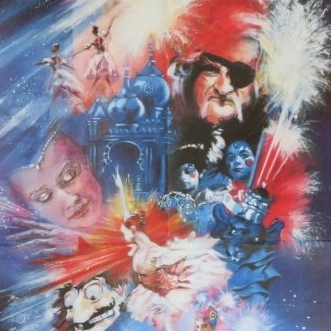Dellamorte Dellamore
Hell is living people.

US poster | October Films
1994 — Italy/France/Germany
A coproduction of AUDIFILM, URANIA FILM, MICHELE RAY GAVRAS for K.G. PRODUCTIONS and le STUDIO CANAL+, in collaboration with SILVIO BERLUSCONI COMMUNICATIONS and BIBO TV AND FILM PRODUCTIONS, and funded by EURIMAGES, presented by TILDE CORSI
Cast: RUPERT EVERETT with FRANCOIS HADJI‑LAZARO and ANNA FALCHI
Director: MICHELE SOAVI
Producers: TILDE CORSI, GIANI ROMOLI and MICHELE SOAVI
Co- and Executive Producers: CONCHITA AIROLDI and DINO DI DIONISIO
Screenplay by: GIANNI ROMOLI
Original work by: TIZIANO SCLAVI
Editor: FRANCO FRATICELLI
Cinematography: MAURO MARCHETTI
Production Designer: ANTONIO GELENG
Costume Designers: MAURIZIO MILLENOTTI and ALFONSINA LETTIERI
Special Effects Designer: SERGIO STIVALETTI
Music: MANUEL DE SICA
So as you know, this here trailer is
NOT SAFE FOR WORK!
Despite having a predominantly Italian cast and crew (and generally just being very Italian as like a whole), the film appears to be predominantly shot in English and then dubbed into Italian; noticeably when comparing the English dub to the Italian, the former fits the mouths much better. This isn't entirely unusual; the Italian film industry has a history of being rather in thrall to the dubbing industry with the vast majority of films are overdubbed regardless, and so at some point they decided if that was going to happen anyway, they didn't need to cast people who could actually speak Italian; and so everyone just goes about the filming acting in their preferred language, sometimes without the script even finalised. By the time this was made, they seemed to settle on trying to have most people speak the same language though (often English, presumably because English speaking territories (read: America, mainly) have historically been where the money is, but whose audiences are most likely to be put off by the sound not synching).
A failure upon release for reasons not entirely within its control, Dellamorte Dellamore (or ‘Cemetery Man’ as it’s sometimes known, because I guess the Italian title makes it sound kind of classy like) is one of those film’s that’s gone on to have an afterlife, pun not intended, as a minor classic. It’s based upon a novel (which seemingly hasn’t been translated into English) which ties into but makes no particular reference to the comic series Dylan Dog by the same author (which has, but hahaha I’m not paying the price people are asking for that); the novel was apparently written prior to the start of the comic’s run, but not published until a few years afterwards. The film similarly makes no overt reference to Dylan Dog (though I’ve heard claim that some elements of the screenplay are actually lifted from the comic rather than the novel). If it makes no reference to this comic, as the film certainly does not, you might be wondering why I’m bringing it up. Well, hang on, I’m getting there. It’s mildly convoluted. Essentially the comic establishes at one point (apparently a couple of years before the novel was published) that Dylan and Dellamorte exist in the same world, it also establishes that the latter is the Italianate doppel of the former, and the former’s appearance is based on, drumroll, Rupert Everett, and thus this film required (REQUIRED, DAMN IT!) Rupert Everett to play the lead… at least to hear the producers talk about it. Fortunately for them, Everett was having a bit of a career slump in the early ‘90s, so he was available. Also fortunately for them, he had no idea the original character’s appearance was based on him when he signed on, otherwise he probably would have asked for more money. (Everett, for his part, claims otherwise.)
The loosely structured film follows Francesco Dellamorte (Everett, obviously), the morose caretaker of a small town’s cemetery, whose life is rather inconvenienced by the tendency for the dead therein to rise from their graves within a week. The town, incidentally, has a rather high mortality rate for its size, with a wide array of freak accidents allowing the citizenry to get comedically mangled into an early grave. Yes, there’s a scene where a bus full of boy scouts drives off a cliff; why do you ask? While he makes little secret of the goings on in the cemetery, no one seems especially bothered, after all what are they going to do, especially if Dellamorte isn’t going to fill out the requisite paperwork to have the council deal with it? There’s quite a bit of that that’d need doing, and it’d require interacting with the townspeople which might be even worse. As such it’d be much easier just to shoot the zombies in the head himself when the need arises. Into this scenario arrives a young widow (Anna Falchi), rocking the traditional Sexy Italian Widow™ look, to plant her rich old dead husband; Dellamorte is instantly smitten and sets about seducing her by showing her the fanciest part of the (or any) cemetery: the ossuary. Few things get the ladies as hot and bothered as some skeletons, and they soon have to unleash their passion for each other on the old man’s grave, as is the classy thing to do. He’s rather less forgiving in death than he apparently was in life however, and catching them in flagrante delicto, he soon puts a stop to it, dentally. Bereft of the merry widow, Dellamorte falls into despair, as she seemingly returns again and again, haunting him.
That’s the set up. The film’s largely episodic, with appearances of Falchi who may or may not be a revenant being one of the main throughlines (though she doesn’t necessarily play a part in all the episodes), along with Dellamorte’s increasingly shaky grasp on the reality, or lack thereof, of the situation. The woolly structure is apparently a hangover from the novel, which is reportedly even more episodic and loose; there were attempts in development to mould it into a more conventional screenplay structure, but they couldn’t get it work and so essentially wound up just saying ‘fuck it’. As such, the film kind of meanders about with no definitive end goal in sight. Dellamorte keeps the bubblegum crisis threatening everything perpetual, but for why? The ‘for why?’ is rather why it still works. The official metaphor is that the film is about depression; Dellamorte is stuck. His life is going nowhere, and trying to escape the rut he’s found himself in feels a futile exercise. He spends his days either surrounded by literal corpses who are slaves to their selfish base desires or the living who are better at keeping up hypocritical appearances. The obvious observation is that the dead are more alive than the living who play at respectability and dance around what they really mean and what they really want. Of course, one of the dead’s great desires is to eat flesh, so swings and roundabouts. Maybe the living secretly want to as well. An argument could be made that people often want to consume each other metaphorically. Ha, love, am I right? Dellamorte is caught between the two worlds, and is unable to free himself while everyone else is apparently able to give in so easily.
Despite its nature as a zombie film, wrapped therein is a vast amount of wit and melancholy. I suppose that’s not entirely fair to the zombie film subgenre; god knows that Romero’s films are quite blunt that they’re actually talking about issues beyond just ‘zombies’, with
Dawn of the Dead (1978) delving headfirst into satire territory. The zombies here are perhaps more incidental than usual, being treated largely as an annoyance rather than any sort of instrument of dread. Michele Soavi has quite a good pedigree, having worked with various figures in Italian horror flicks, most (in)famously being a protégé of Dario Argento, most (in)famously of
Suspiria (1977), arguably one of the most influential Italian horror films (if only because it’s one of the most widely seen) with its lurid Technicolor hues, fever dream plot, and copious blood splattering about the place. Argento’s influence is quite obvious, but Soavi also however was a protégé of Terry Gilliam, and Gilliam’s influence seems laced throughout the film; in the production design, in the humour, and perhaps the film’s wistful core. Of course, said core eventually leads the film to a peculiar dead end; given the vagaries of the plot, it’s perhaps inevitable (the film even foreshadows it), but it’s the journey, not the destination and all that, and the journey there is genuinely pretty great.
At time of writing, Dellamorte Dellamore is available for rent on Amazon and is streaming on Amazon and BFI Player, amongst other services. I recommend JustWatch for keeping up with where films are streaming (including this one!). Alternatively, physical copies are reportedly available for rent via Cinema Paradiso.
The film has an 18 rating these days, the BBFC claiming "strong violence, gore and nudity".
And, yes, I know that "Hell is other people" is really about gaze rather than other people being the worst.



